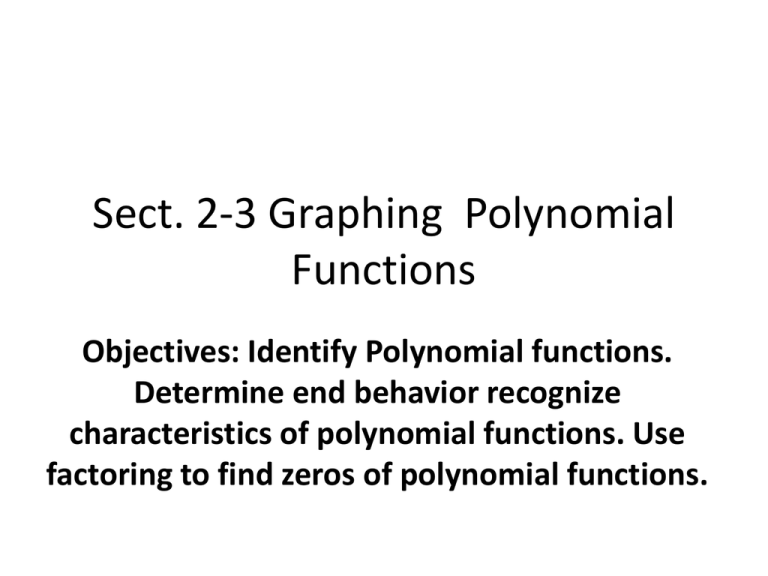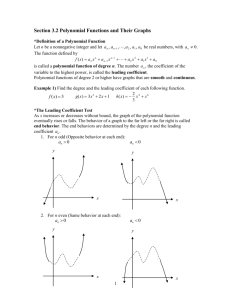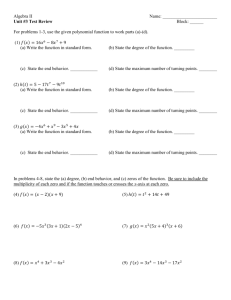Sect. 2-3 Graphing Polynomial Functions
advertisement

Sect. 2-3 Graphing Polynomial Functions Objectives: Identify Polynomial functions. Determine end behavior recognize characteristics of polynomial functions. Use factoring to find zeros of polynomial functions. • Polynomials of degree 2 or higher have graphs that are smooth and continuous. By smooth we mean the graphs have rounded curves with no sharp corners. By continuous we mean the graphs have no breaks and can be drawn without lifting your pencil from the rectangular coordinate system. Odd degree polynomial functions have graphs with opposite behavior at each end. Even degree polynomial functions have graphs with the same behavior at each end . The Leading Coefficient Test • For n odd If the leading coefficient is positive The graph falls to left and rises to the right. F(x) = x3 +3x2 –x-3 Rises Right For n odd If the leading coefficient is negative The graph rises to left and falls to the right. Rises left Falls left Falls Right F(x) = -x3 + 2x 2 The Leading Coefficient Test Pt. 2 For n even If the leading coefficient is positive The graph rises to left and to the right. F(x) = x4 + 3x 3 +2x2 For n even If the leading coefficient is negative The graph falls to left and to the right. F(x) = - x4 + 8x 3 +4x2 +2 Example : Using the Leading Coefficient Test f ( x) = -49x 806 x 377 x 2503 3 The leading coefficient - 49 is negative 2 The degree of the polynomial is odd Example : Using the Leading Coefficient Test f ( x) = -x 8 x 4 x 2 4 The leading coefficient -- 1 is negative 3 The degree of the polynomial is even 2 Finding how many turns are possible The number of turns is determined by n- 1 x 3x x 3 3 2 Since the degree is 3 the number of turns = 3-1 or 2 Step2: Find the no of zeros by factoring x ( x 3) 1( x 3) 2 ( x 3)( x 1) 0 2 x 3 0 or x 2 1 0 x = -3 x2 = 1 x= 1 • So your zeros are • -3, 1 and -1 Multiplicity and x- intercepts We can use factoring to express a polynomial as a product of factors. For instance we can use our factoring to express the functions equations as follows f(x) = -x 4x 4x ( x 4x 4x ) x ( x 4x 4) 4 3 2 4 3 2 2 2 Notice that each factor occurs twice. In factoring the equation for the polynomial function f , if the same factor x-r occurs k times but not k+1 times we call r a zero with multiplicity k For the polynomial function f ( x) = x 2 ( x 2) 2 0 and 2 are both zeros with multiplicity of 2. Multiplicity and x- intercepts Multiplicity and x-intercepts If r is a zero of even multiplicity then the graph touches the x axis. And turns around at r . If r is a zero of odd multiplicity. Then the graph crosses the x axis at r . Regardless of whether the multiplicity of a zero is even or odd graphs tend to flatten out at zeros with multiplicity greater than one. Finding zeros and their multiplicities Find the zeros of f(x) = (x+1)(2x -3)2 and give the multiplicity of each zero ( x 1)(2 x 3) x 1 0 x = -1 The exponent is 1 Thus the multiplicity of -1 is 1 2 0 2x -3 =0 2x = 3 3 x= 2 The exponent is 2 Thus the multiplicity of 3/2 is 2 Example Finding Zeros and their Multiplicities Find the zeros of f ( x) =(x 1)(2 x 3) 2 and give the multiplicity of each zero (x 1)(2 x 3) 2 0 Set each factor equal to zero x 1 0 x = -1 2x - 3 = 0 3 x= 2 -1 is a zero of odd multiplicity. Graph crosses x axis The results -1 is a zero of even multiplicity. Graph touches x axis and flattens out and turns around. Graphing a Polynomial Function 1. Use the Leading coefficient to determine the graphs end behavior. 2. Find the x- intercepts by setting f(x) = 0 and solving the resulting polynomial equation. If there is an x – intercept at r as a result of (x- r)k in the complete factorization of f(x) then. a. If k is even the graph touches the x axis at r and turns around . b. If k is odd the graph crosses the x axis at r c. If k >1 the graph flattens out at (r,0) . 3. Find the y – intercept by computing f(0) 4. Use symmetry if applicable to help draw the graph. a. Y- axis symmetry: f(-x) = f(x) b. Origin symmetry: f(-x) = - f(x) 5. Use the fact that the maximum number of turning points of the graphs is n-1 to check whether it is drawn correctly. Homework 1-26 pg.66-67 Or 1-64 (multiples of 4 )pgs.297-298








